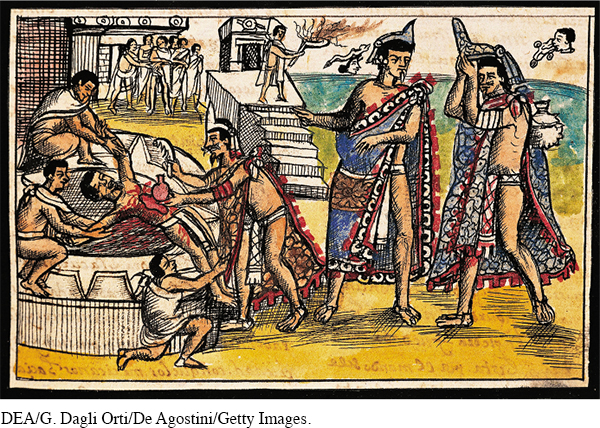Why was tribute important in the Mexican empire?
The vast majority of the millions of people who lived in the Western Hemisphere in the 1490s inhabited Mesoamerica and South America, where the population approximately equaled that of Europe. Like their much less numerous counterparts north of the Rio Grande, these people lived in a natural environment of tremendous diversity. Among all these cultures, the Mexica stood out. Their empire stretched from coast to coast across central Mexico, encompassing approximately six million people. Their significance in the history of the New World after 1492 dictates a brief survey of their culture and society.
> CHRONOLOGY
ca. AD 1325
|
ca. 1490
|
AD 1492
|
The Mexica began their rise to prominence about 1325, when small bands settled on a marshy island in Lake Texcoco, the site of the future city of Tenochtitlán, the capital of the Mexican empire. Resourceful, courageous, and cold-blooded warriors, the Mexica were often hired out as mercenaries for richer, more settled tribes.
By 1430, the Mexica succeeded in asserting their dominance over their former allies and leading their own military campaigns in an ever-widening arc of empire building. Despite pockets of resistance, by the 1490s the Mexica ruled an empire that contained about as many people as lived in Spain. The empire exemplified the central values of Mexican society. The Mexica worshipped the war god Huitzilopochtli. Warriors held the most exalted positions in the social hierarchy, even above the priests who performed the sacred ceremonies that won Huitzilopochtli’s favor. In the almost constant battles necessary to defend and extend the empire, young Mexican men exhibited the courage and daring that would allow them to rise in the carefully graduated ranks of warriors. The Mexica considered capturing prisoners the ultimate act of bravery. Warriors usually turned over the captives to Mexican priests, who sacrificed them to Huitzilopochtli by cutting out their hearts. The Mexica believed that human sacrifice fed the sun’s craving for blood, which kept the sun aflame and prevented the fatal descent of everlasting darkness and chaos.[[LP Photo: P01.13 Mexican Human Sacrifice/

The empire contributed far more to Mexican society than victims for sacrifice. At the most basic level, the empire functioned as a military and political system that collected tribute from subject peoples. The Mexica forced conquered tribes to pay tribute in goods, not money. Tribute redistributed to the Mexica was as much as one-third of the goods produced by conquered tribes. It included everything from candidates for human sacrifice to textiles and basic food products as well as exotic luxury items such as gold, turquoise, and rare bird feathers.
Tribute reflected the fundamental relations of power and wealth that pervaded the Mexican empire. The relatively small nobility of Mexican warriors, supported by a still smaller priesthood, possessed the military and religious power to command the obedience of thousands of non-noble Mexicans and of millions of non-Mexicans in subjugated colonies. The Mexican elite exercised their power to obtain tribute and thereby to redistribute wealth from the conquered to the conquerors, from the commoners to the nobility, from the poor to the rich. This redistribution of wealth made possible the achievements of Mexican society that amazed the Spaniards after AD 1492: the huge cities, teeming markets, productive gardens, and for parallel structure storehouses stuffed with gold and other treasures.
> UNDERSTAND
POINTS OF VIEW
How did the subjects of the Mexican empire view the Mexican priests and warriors?
On the whole, the Mexica did not interfere much with the internal government of conquered regions. Instead, they usually permitted the traditional ruling elite to stay in power—so long as they paid tribute. Subjugated communities felt exploited by the constant payment of tribute to the Mexica. The high level of discontent among subject peoples constituted the soft, vulnerable underbelly of the Mexican empire, a fact that Spanish intruders exploited after 1492 to conquer the Mexica.
> QUICK REVIEW
How did the conquest and creation of an empire exemplify the central values of Mexican society?
Understanding the American Promise 3ePrinted Page 22